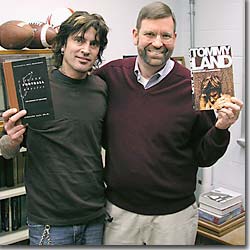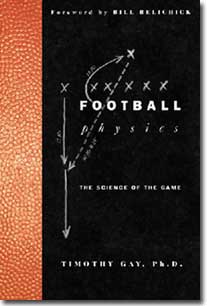Timothy Gay
Timothy Gay of the University of Nebraska often engages in what he calls “physics propaganda.” He says, “As working scientists, we need to explain to the public why what we’re doing is cool and interesting.” In fact, Gay has recently promoted physics while appearing on a primetime reality TV show with rocker Tommy Lee (though Gay says “reality is overstating the case”).

Tommy Lee and Timothy Gay exchange books.
In the show, “Tommy Lee goes to College” (NBC), middle-aged rocker Tommy Lee attends the University of Nebraska as a student, in order to capture the college experience he skipped in order to start the rock band Motley Crue when he was 19. Some University of Nebraska faculty and administrators were initially nervous about the show, and about having the notorious Tommy Lee on campus, says Gay, but “the rest of us were like, ‘Rock on, dude!’” So Gay agreed to have Tommy Lee attend his class, and to play the role of Tommy Lee’s academic advisor. “I like to have fun,” says Gay, “He turned out to be a really nice guy. I was pleased to work in a little physics into the show.”
Gay says he got along well with Lee, who actually did seem interested in Gay’s physics lab. “He was intrigued by all the apparatus. I talked to him about how a research group actually works,” says Gay. On the show’s first episode, Gay shows Tommy Lee his lab, and explains some of the equipment. “We got in about five minutes of physics, and I’m actually describing to him my lab. Real physics got put on TV for three or four minutes. I was describing polarized electrons.”
Polarized electrons, which Gay’s lab studies, are basically electrons that are all spinning along one direction. One of Gay’s research projects involves investigating polarized electron scattering by chiral molecules. Like a right and left hand, chiral molecules cannot be superimposed on their mirror images, no matter how you rotate them. A DNA spiral is an example of a chiral molecule. Although a right-handed molecule might be the mirror image of a left-handed one, they don’t always behave in perfect mirror image ways. Gay is working to measure some of these slight differences, such as in the way chiral molecules scatter polarized electrons. One motivation for this research, explains Gay, is that all DNA happens to be right-handed, and scientists don’t understand why, though there are some theories. Gay hopes his research may help shed some light on the problem.
Gay’s group is also working on several other research projects, including experiments to measure the details of how angular momentum gets divided up among the collision fragments when photons or charged particles hit an atomic or molecular target. These fundamental studies will help give physicists a better basic understanding of the scattering process, says Gay.

When he’s not hanging out with rock stars, teaching classes, or doing physics research, Gay might be found out rooting for his favorite football team, the University of Nebraska Cornhuskers, or explaining the physics of the game to other football fans.
“The basic problem that we have as physicists is that people don’t want to do the work to understand physics,” says Gay. People might be more interested in physics if they see how it relates to something they care about, says Gay, and “In Nebraska, what people care about is football.”
So he has put together a series of short lessons that Cornhuskers fans watch on large television screens during breaks in the action. The lessons explore topics such as Newton’s laws, energy and momentum, air resistance, and atoms and photons, as they relate to football. In 2001, NFL films hired Gay to do a series of five-minute television segments on the physics of football. Gay has even written a popular book called Football Physics.
Though he often has to work hard to interest others in physics, Gay himself was interested at a very young age. He grew up in a small town in western Ohio, where the only school had grades k-12 all in one building. In kindergarten, he would peer through the window of the chemistry lab across the hall, and was fascinated by what he saw. He was also inspired by Marie Curie, and read several biographies of her. Though initially intrigued by chemistry, Gay soon became even more interested in physics, because, he says, “physics seemed like it had cooler toys.”
By age 8 he felt quite certain that he wanted to be a physicist, and he never changed his mind. He majored in physics at Caltech, and then completed his PhD at the University of Chicago, before becoming a professor of physics. Gay agrees it is very unusual for someone to have found his passion for physics at such a young age. He points out that many of the undergraduates he teaches still have no idea what they want to do with their lives.
Some fellow physicists might worry that he spends too much time promoting physics, or that he promotes physics in a less than serious a way, says Gay, but he doesn’t see it that way. “The point is that you can be a serious scientist, and still try to make it available to the public,” he says. “You can do both.”











